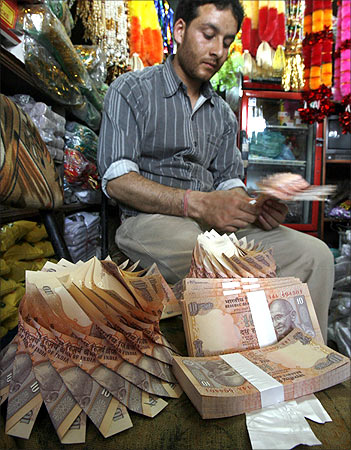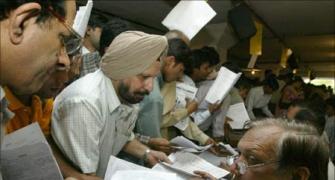India Inc’s scorecard in the quarter ended March 2015 was even weaker
 India was the world’s second-fastest-growing economy in 2014-15, with its gross domestic product growing 7.3 per cent, next only to China’s 7.4 per cent.
India was the world’s second-fastest-growing economy in 2014-15, with its gross domestic product growing 7.3 per cent, next only to China’s 7.4 per cent.
This bullishness about the economy, however, did not reflect in India Inc’s books of account.
The combined net sales of around 1,700 Indian companies (excluding financial and oil and gas ones) rose 5.9 per cent on a year-on-year basis -- the slowest rate in two years. India Inc’s bottom line fared worse, with core operating profit (excluding other income) declining 0.5 per cent annually, and net profit falling 7.45 per cent.
In 2013-14, these companies’ net sales and operating profit had grown 9.6 per cent and 11.6 per cent, respectively, while their net profit had grown 1.7 per cent.
Historically, when India’s GDP has grown 7.5 per cent at constant prices, corporate revenues have grown an average 14-15 per cent, and profits about 20 per cent.
India Inc’s scorecard in the quarter ended March 2015 was even weaker, with near-flat revenue growth and decline in profits.
While companies’ net sales grew only 0.4 per cent on a year-on-year basis during the quarter, their operating and net profits declined 22.2 per cent and 59.9 per cent, respectively.
The numbers were the worst in three years.
By comparison, India’s GDP growth rate, according to the Central Statistics Office, accelerated to 7.5 per cent in the quarter from 6.6 per cent the previous one.
This growing variance between India Inc’s performance and headline GDP numbers seem to have baffled economists and analysts.
“Corporate numbers and the new GDP series present contrasting pictures of the economy. This is a conundrum, but we have to accept GDP numbers as another official fact,” says Devendra Pant, chief economist and head of public finance at India Ratings. He attributes the gap partly to the unorganised sector’s inclusion in CSO’s calculation methodology; corporate numbers essentially correspond to only the organised sector.
Market analysts are more critical.
“We are not looking at the GDP numbers at present. Corporate numbers are what matter to the markets; these show a continued slowdown and lack of adequate demand in the economy,” says Dhananjay Sinha, head of institutional equity at Emkay Global Financial Services.
Corporate profits fell in spite of considerable gains from a decline in commodity prices.
Raw material and energy intensity for companies in the sample came down by 600 basis points on a year-on-year basis to a three-year low of 61 per cent, thanks to the plunge in the international prices of metals, crude oil, coal and sugar (100 basis points equal one percentage point).
In other words, producing Rs 100 worth of net sales in 2014-15 cost Rs 61 worth of raw materials and fuel & power, compared with Rs 67 the previous year.
This translated into a cost saving of Rs 2.16 lakh crore (Rs 2.16 trillion), or around $34 billion by the current exchange rate, for the companies in the sample.
If it was not for this saving, the companies’ operating profits would have been lower by 37.8 per cent and they would have posted a combined net profit of only Rs 2,301 crore (Rs 23.01 billion), against Rs 2.11 lakh crore (Rs 2.11 trillion) of reported profits for 2014-15.
Given the recent rise in crude oil prices, corporate numbers for the June quarter of 2015-16 are likely to stay subdued, too.
And, the performance could stay weak if the demand environment remains soft.
“Decline in input prices allowed companies like Hindustan Unilever to push volumes by cutting prices.
“The recent surge in crude oil prices has reduced that cushion for manufacturing companies,” says Sinha.
In many ways, the economic slowdown for India Inc is now more widespread.
While a demand slowdown in the past was largely restricted to investment-driven sectors like capital goods, construction and infra, power and metals, this is now seen in consumption and export demands as well.
For fast-moving consumer goods companies, the March quarter was the weakest in three years in terms of revenue and profit growth.
Similarly, the export-intensive IT companies and drug makers, which were pulling the corporate earnings in the previous three years, were hit by a demand slowdown in the quarter.
“The near-term outlook for consumption growth will remain bleak, unless the government reverses its austerity measures in the latter half of 2015-16.
“Faster growth for IT and pharma companies would require a fresh round of rupee depreciation,” adds Sinha.
Now, all hopes are pegged to a rapid scale-up of public investment in the infrastructure sectors like highways, railways, urban transport and airports.
However, doubts over this persist, given the excess capacity across sectors and debt-laden balance sheets of infrastructure companies.










